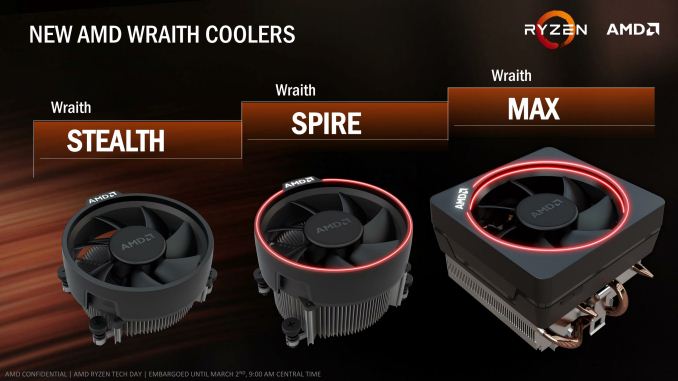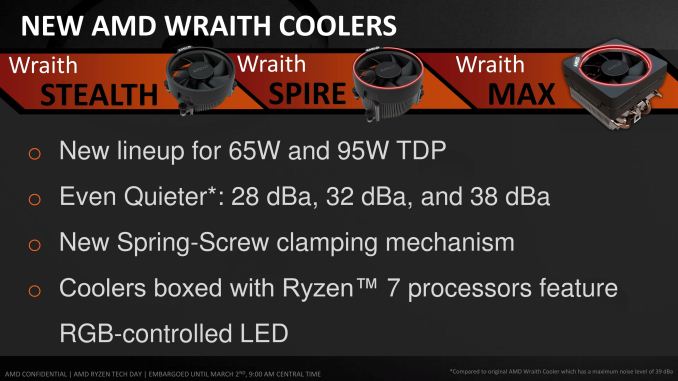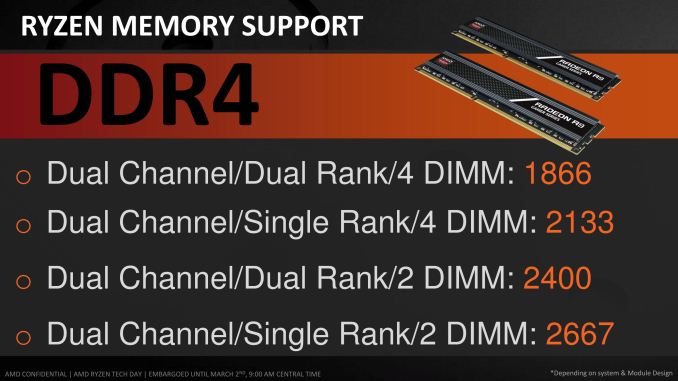The AMD Zen and Ryzen 7 Review: A Deep Dive on 1800X, 1700X and 1700
by Ian Cutress on March 2, 2017 9:00 AM ESTAMD Stock Coolers: Wraith v2
When AMD launched the Wraith cooler last year, bundled with the premium FX CPUs and highest performing APUs, it was a refreshing take on the eternal concept that the stock cooler isn’t worth the effort of using if you want any sustained performance. The Wraith, and the 125W/95W silent versions of the Wraith, were built like third party coolers, with a copper base/core, heatpipes, and a good fan. In our roundup of stock coolers, it was clear the Wraith held the top spot, easily matching $30 coolers in the market, except now it was being given away with the CPUs/APUs that needed that amount of cooling.
That was essentially a trial run for the Ryzen set of Wraith coolers. For the Ryzen 7 launch, AMD will have three models in play.
These are iterative designs on the original, with minor tweaks and aesthetic changes, but the concept is still the same – a 65W near silent design (Stealth), a 95W near silent design (Spire), and a 95W/125W premium model (Max). The 125W models come with an RGB light (which can be disabled), however AMD has stated that the premium model is currently destined for OEM and SI designs only. The other two will be bundled with the CPUs or potentially be available at retail. We have asked that we get the set in for review, to add to our Wraith numbers.
Memory Support
With every generation of CPUs, each one comes with a ‘maximum supported memory frequency’. This is typically given as a number, with the number aligning with the industry standard JEDEC sub-timings. Technically most processors will go above and beyond the memory frequency as the integrated memory controller supports a lot more; but the manufacturer only officially guarantees up to the maximum supported frequency on qualified memory kits.
The frequency, for consumer chips, is usually given as a single number no matter how many memory slots are populated. In reality when more memory modules are in play, it puts more strain on the memory controller so there is a higher potential for errors. This is why qualification is important – if the vendor has a guaranteed speed, any configuration for a qualified kit should work at that speed.
In the server market, a CPU manufacturer might list support a little differently – a supported frequency depending on how many memory modules are in play, and what type of modules. This arguably makes it very confusing when applied at a consumer level, but on a server level it is expected that OEMs can handle the varying degree of support.
For Ryzen, AMD is taking the latter approach. What we have is DDR4-2666 for the simplest configuration – one module per channel of single rank UDIMMs. This moves through to DDR4-1866 for the most strenuous configuration at two modules per channel with dual-rank UDIMMs. For our testing, we were running the memory at DDR4-2400, for lack of a fixed option, however we will have memory scaling numbers in due course. At present, ECC is not supported ECC is supported.













574 Comments
View All Comments
Notmyusualid - Sunday, March 5, 2017 - link
@ prisonerXPossibly, but with dollars in our pockets, that others want. Hence this product release.
prisonerX - Sunday, March 5, 2017 - link
Yes, obviously this product release was just for gamers. Thank you for proving my point.Notmyusualid - Monday, March 6, 2017 - link
You are most welcome!divertedpanda - Saturday, March 4, 2017 - link
I doubt gamers make a majority of the people who can afford $150+ CPUs... Content Creators/Prosumers probably make the bank for these kind of purchases....Notmyusualid - Monday, March 6, 2017 - link
@ Meteor2I do too.
nobodyblog - Friday, March 3, 2017 - link
AMD claimed that Every core is really one core, but now, we know it is at least two cores, because everything is more...It won't be able to be well in different scenarios specially in less threads and even gaming. I doubt their patch works.. It is very bad in IPC, and performance wise it is a garbage in 16 nm...
Thanks!
Thanks!
nobodyblog - Friday, March 3, 2017 - link
I mean 14 nm FinFet..charliebi - Friday, March 3, 2017 - link
want to setup a gaming rig? Buy a 7700K, or better save something and buy a 7500 or 7600 and put the savings on a gtx 1080 ti. That's all gamers need to know.007ELmO - Friday, March 3, 2017 - link
what if I want to build 4 gaming rigs for a LAN? does the 1080ti and AMD chip run under 500W power requirement?Outlander_04 - Saturday, March 4, 2017 - link
Gamers , like everyone else, need to buy using their brains and not prejudices.First up decide if you are going to use a 1080p/ 60 Hz monitor . If you are then you do not need either an i7 7700 or a 1080ti .
If you want that resolution and you have a 144 hz monitor then there is a case for using an intel quad.
If you are gaming at 4K, 1440p or with a high resolution ultra wide then Ryzen will also do the job very well and be a far better encoder. For those users the AMD chip looks to be very very good v
value